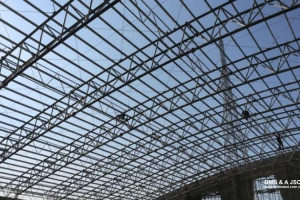What is the steel structure painting process?
The steel structure painting process is crucial for ensuring the durability and aesthetics. By following a meticulous steel structure painting process, BMB Steel protects its products from corrosion and environmental damage, ensuring long-lasting performance.
What is steel structure paint?
Steel structure paint is a specialized coating designed to protect and enhance the durability of steel components such as columns, beams and frameworks used in various constructions like bridges, buildings, factories and industrial projects. Over time, these structures are susceptible to rust, wear and environmental impacts. Therefore, steel structure paint provides a protective layer against corrosion, extending the lifespan of the structures and reducing maintenance costs.

What are the types of steel structures painting?
Steel structure paints are mainly categorized into three types: Alkyd paint, Epoxy paint and Polyurethane (PU) paint, each with its distinct characteristics and applications.
Alkyd paint
This oil-based paint is favored for steel components. Its primary ingredient is Alkyd resin, derived from plant sources, which provides excellent adhesion to surfaces and quick drying time. Alkyd paint is also noted for its rust resistance and color retention, even in corrosive environments.
Epoxy paint
A premium paint made from two components: solvent and polyamide hardener. This type of paint is suitable for both new and existing steel structures. However, its adhesion is not as strong as Alkyd paint, necessitating thorough cleaning and surface roughening to prevent peeling.
Polyurethane paint
Known for its long-lasting protective qualities, PU paint is commonly used on machinery, steel structures, both indoors and outdoors, storage tanks, underground pipes, duct systems, bridges, boats and various industrial projects. Key advantages of PU paint include rapid drying, a hard surface, good impact and abrasion resistance, corrosion protection, effective adhesion and resistance to UV rays, solvents and chemicals.

Advantages and disadvantages of steel structure painting standards
The steel structure painting standard is a method used to protect painted steel surfaces from oxidation, helping to extend the lifespan of the structure over time. However, like any protective method, it comes with its own set of advantages and disadvantages.
Advantages of steel structure painting standards
- Cost-Effective: This method is generally cheaper than other protective techniques such as heat treatment or galvanization.
- Environmentally Friendly: It does not involve harmful substances while still providing excellent corrosion resistance and protection against oxidation for steel structures.
- Smooth Finish: The process results in a smooth surface, making it easier to clean.
- UV and Weather Resistance: It effectively withstands sunlight, ultraviolet rays, and rain exposure.
Disadvantages of steel structure painting standards
- Low Fire Resistance: The paint has a low ignition point, which can lead to severe accidents in unexpected situations.
- Peeling and Wear: Compared to other protective methods, the paint may peel and lose its abrasion resistance more quickly, especially in humid environments with fluctuating temperatures.
- Limited Mechanical Protection: It offers reduced protection against mechanical impacts such as collisions and abrasion.
The most standardized painting process for steel structures
To ensure optimal protective effectiveness for steel structures, the painting process should follow these standard steps:
Step 1: Choose an appropriate application method
Select a painting method that aligns with the type of paint and characteristics of the project. Options may include spraying, brushing, or rolling, depending on the actual conditions and technical requirements.
Step 2: Prepare and treat the steel surface
Surface treatment is a crucial step in the steel painting process. Cleaning and removing grease and rust will enhance paint adhesion. Common methods include sandblasting, steelball blasting or solvent cleaning.
Step 3: Apply a primer coat
The primer coat enhances the adhesion of the topcoat and protects the steel surface from corrosion. Choosing the right primer will facilitate a smooth painting process and provide optimal protective results.
Step 4: Apply the topcoat
The topcoat serves as the primary protective layer and contributes to the aesthetics of the structure. During the standard painting process, ensure the topcoat is applied evenly without drips and reaches the required thickness.
Step 5: Inspect, address defects and deliver the project
After completion, inspect the entire surface for defects such as peeling, cracking, or dripping paint. The painting process will only be deemed complete when all issues are resolved and meet the standard acceptance criteria for steel structure painting.

Notes for applying protective paint on steel structures
When applying protective paint to steel structures, contractors must adhere to several important guidelines to ensure the quality and longevity of the project:
- Conduct a thorough inspection of the steel surface to ensure all rust, dust and grease are completely removed. Clean and treat the surface to achieve a smooth, roughness and uniform finish.
- Select the paint type based on the specific requirements of the project and environmental conditions. The chosen paint should have high durability, resistance to wear and the ability to withstand weather impacts without easily accumulating dirt.
- During mixing, contractors must follow the correct ratios and technical procedures to ensure uniform color and quality of the paint layer.
- The application must utilize appropriate technology and equipment to ensure an even thickness of the paint layer, preventing drips, clumping, or inconsistencies.
- Surrounding areas should be thoroughly cleaned and protected to avoid impact, allowing the paint sufficient time to dry completely and achieve optimal quality.

The standard steel structure painting process ensures sustainable protection for projects, enhances aesthetic appeal and prolongs the lifespan of the structure. By adhering to the steps outlined by BMB Steel, optimal results can be achieved for all construction projects.

























